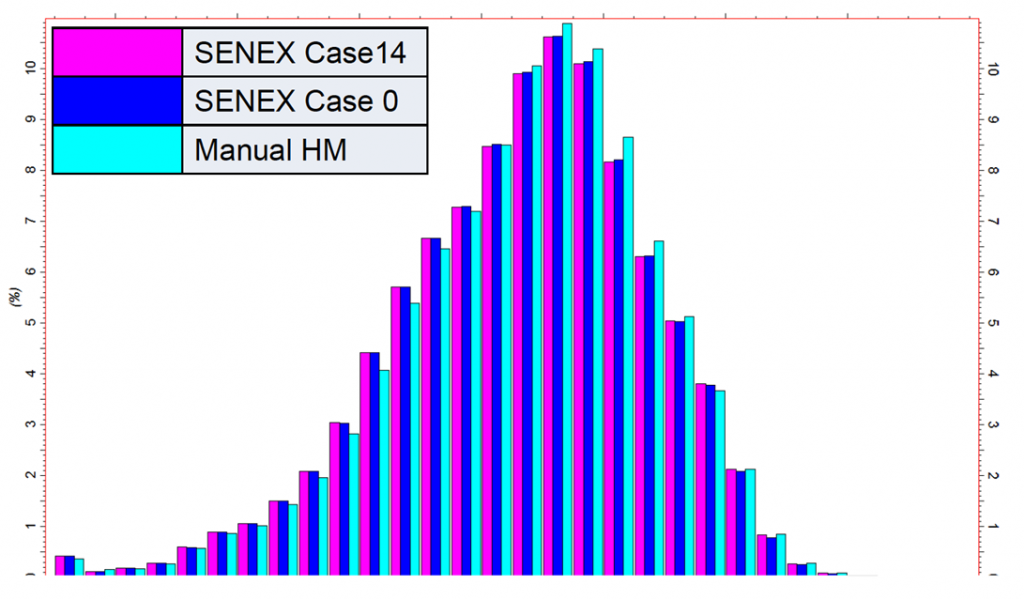SenEx
-

SenEx - THE ADVANCED TOOL
FOR RAPID AND SUPERIOR
HISTORY MATCHINGThe Game-Changer for
Assisted History Matching
-

WELL-LEVEL HISTORY
MATCHING AT ITS BESTArrive at Geologically Consistent Models.
No Need for Box Multipliers.
-

SenEx SIGNIFICANTLY SPEEDS UP THE HISTORY MATCHING EXERCISE
Achieve a High-Quality History Match With Less Than 20 Simulation Runs, No Matter How Many Wells to Match.

Sensitivity Explorer – The Disruptive History Matching Tool

Revolutionise Your History Matching Workflow
Until now history matching was a trial-and-error process, often cumbersome and time consuming, especially for big and mature fields with many wells. The industry has therefore developed computer assisted history matching tools. These tools require enormous computing power and typically hundreds of iterations yet individual well match quality is often quite poor.
Our SenEx (Sensitivity Explorer) is different: It is smart, requires only 10 – 20 simulation runs and dramatically improves the quality of your history match. What typically took months can now be achieved in days. SenEx stands for innovation and technology. It reduces turnaround time, saves manpower, licensing costs and mitigates risk as investment decisions are based on better reservoir models.
SenEx has been developed continuously over more than a decade and successfully applied in numerous field studies on reservoirs in different parts of the world.
Why SenEx?
- Significantly reduces number of required simulation runs, CPU and simulator usage.
- Saves time, money and manpower
- Is easy to use
- Generates geologically sound and consistent models
- Preserves known geological features of the original model to a great extent
- Works at the grid block level eliminating the need for “multiplier boxes”
- Fits in any history matching workflow
- Supports various black-oil reservoir simulators
SenEx has been successfully applied in numerous field studies on reservoirs in different parts of the world.
How It Works
Will SenEx improve your history match? Yes. Will it replace expert Reservoir Engineers? No.
But SenEx helps save experts’ time during matching freeing them up for other mission-critical tasks. Using SenEx is extremely easy and can fit into most history matching workflows. After each simulation run, SenEx generates new property arrays to be used in the next run leading to a significant improvement in every simulation run. This loop is repeated until a satisfactory match is finally reached. This approach saves time and money and considerably cuts the amount of human resources required. Compared to other tools that require hundreds of simulation runs, SenEx usually achieves a high quality match after 10 to 20 iterations.
Watch Our Demo Video

By loading the video, you agree to YouTube's privacy policy.
Learn more
Modules
SenEx Base
The basic module for the sensitivity analysis
SenEx GUI
The graphical user interface providing the workflow, easy objective function definition and parameter specifications & modifications as well as a flexible auto-loop function
SenEx Dual
An additional module that allows dealing with dual porosity / dual permeability models including fracture porosity & permeability and matrix-fracture connections
The Future of History Matching – What Makes The Difference
Ordinary history matching tools compute sensitivities by repeatedly running the simulator while varying the parameters. The number of required simulation runs increases dramatically as the number of parameters to be evaluated is increased.
Contrary to other tools, SenEx treats every rock property at every grid block as individual parameters and analytically calculates how the properties affect the history match in a given simulation case. Based on these analytical sensitivities, SenEx captures what grid block properties need to be changed, where, and how, in order to improve the history match quickly. The changes are kept minimal: only as needed. This leads to geologically sound and consistent models.
SenEx provides the user with maps showing how the properties at each and every grid block affect the match. This indicates how the model needs to be modified in order to improve the history match; an exercise that would otherwise be a tough and tedious trial-and-error process.

Permeability variograms remain largely unchanged
Key Publications
SPE 131627:
History-Matching with Sensitivity-Based Parameter Modifications at Gridblock Level
Authors: Hussein Almuallim, Kelly Allan Edwards (Barrick Energy Inc), Leonhard Ganzer (Tech. U. Clausthal)
SPE 165979:
Computer Assisted History Matching – A Field Example
Authors: R. H. Lind (HOT Engineering), O. Allottai (Akakus Oil Operations), A. M. Gaaim (NOC Libya), H. Almuallim (Firmsoft Technologies)
Authors: Hussein Almuallim (HOT FirmSoft Solutions FZ-LLC), Leonhard Ganzer (HOT FirmSoft Solutions FZ-LLC), Hiroshi Uematsu (ADNOC Offshore), Samir Bellah (ADNOC Offshore), Viorel Virlan (ADNOC Offshore)
Request a SenEx Demo Licence
© All rights reserved
HOT Engineering GmbH Tel: +43 3842 43 0 53-0 Fax +43 3842 43 0 53-1 hot@hoteng.com
